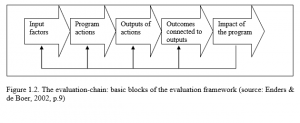It’s now been two weeks and they’ve flown past! While by no means an expert, I can safely say I understand the issue of youth unemployment in much more depth now. Over the past week, I have been working on my mini-project which has now been confirmed.
Before comparing projects, it is important to finalise the criteria that will be used; they vary widely and can often be hard to measure. Prior to my involvement in the project, the team had created an Excel spreadsheet which brought the criteria together from different research papers. For my mini-project, I am going through these papers again and contextualising the criteria; this involves summarising the paper, focusing on the challenges faced by India in particular, and creating a model which can be used to compare projects. Here is an example:
Taken from one of the papers I have been reading, it gives the flowchart of a typical intervention that aims to deal with youth unemployment. This particular one focuses on TVETs – Technical Vocational Education and Training programs. A suitable criteria could be based on inputs (time invested, financial cost etc.) or outputs (skills gained by beneficiary, their salary etc.). The difference between outputs (which are individual to the beneficiary) and outcomes (which are large-scale changes, such as productivity of the company or rate of unemployment) is important when choosing criteria for success. I am currently working on a framework which outlines what my project report will cover. I will then start writing the report, aiming to finish it next week so I can get feedback and improve it before a final submission in week four.
Finally, to finish off, I just wanted to emphasise the importance of context in the papers I have been reading. This statistic highlights it particularly well:
- “ITCs spend 61.2% of their expenditure on staff“.
- “ITIs spend 92.1% of their expenditure on staff”.
ITIs and ITCs are institutions that are involved in running the TVET program, with the key difference being source of funding – ITIs are funded (at least partially) by the Government whereas ITCs are private institutions. As the author goes on to mention, this seems to imply that ITCs are more efficient with their allocated budget. However, the reality is that ITCs are often understaffed and employ teachers who lack training – naturally this leads to lower salaries and a lower spending on staff for ITCs. This simple difference can skew the comparison significantly, leading to a biased and unfair representation of the programs. This is a systematic error that needs to be dealt with before project comparison begins – and it is one which I am helping to solve!
